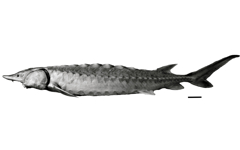Atlantic Sturgeon
VIMS Fish Collection
Catalog Number: VIMS 12208
Length: 78 centimeters (2.6 feet)
Collection Locality: James River, VA
Accession Date: 2009
The Atlantic Sturgeon, Acipenser oxyrinchus, is one of 25 species of sturgeon found world-wide today. As may be expected from their unusually ancient appearance, sturgeons generally have a long fossil record, dating back to the Late Cretaceous (about 85 million years ago). Most of the known fossil remains of sturgeons, however, consist of isolated bony plates (called scutes), skull bones, and pectoral fin spines, which are similar in their form among all species of sturgeons. Therefore, little is known about the species-level diversity of sturgeons since the time of the dinosaurs.
Characteristics
As in all species of sturgeons, Atlantic sturgeon have 5 rows of bony plates—also called scutes—along the length of their bodies, elongate snouts supporting electrosensory organs and 4 well-developed barbels that are covered with taste-buds, and shark-like tails. The large pectoral fin is armed by a thick spine, which can be used to age individual fish by counting growth rings. Atlantic sturgeon may live at least 30 years, with some reports of 60 years or older, though they may reproduce only once every 3 to 5 years. The largest known specimen of Atlantic sturgeon was a 4.27-meter (14 feet) long female caught in the Saint John River in New Brunswick, Canada.
Habitat
Atlantic sturgeon reside in the large rivers and near-shore environments of the East Coast of North America. Like many species of sturgeon, the Atlantic sturgeon is anadromous and livies most of its life in marine and estuarine environments, but migrates up large rivers to spawn over rocky substrate. Larvae and juveniles live in the freshwater riverine habitats before migratng to marine environments at between 2 and 6 years of age, depending on sex (males leaving the rivers earlier) and location. Adult Atlantic sturgeon migrate up river to spawn in the spring—males may spend most of the summer in the rivers whereas females generally (though not always) migrate back to sea soon after spawning.
Feeding/Diet
The Atlantic sturgeon has a vacuum-like mouth that projects far from the bottom surface of the head. Reflective of their jaw structures, sturgeons feed largely on aquatic insects, amphipods, isopods, shrimps, molluscs, and some fishes that live in the substrate. As larvae, sturgeons have teeth, although these are lost very early in development and the jaws of juveniles more than about 1.5 inches in length and all adult sturgeons are without teeth.
Conservation
Atlantic sturgeon were once abundant in Chesapeake Bay and were an important source of food to native Americans and colonists. Atlantic sturgeons were heavily fished for roe (caviar) and flesh at the end of the 19th century. In addition, the anadromous Atlantic sturgeon has also suffered to a great extent from habitat alteration by degradation of spawning and nursery habitats. The peak Atlantic coast catch of Atlantic sturgeon (7,382,000 pounds) occurred in 1890, declining to 650,000 pounds by 1901, and further declining to less than 100,000 pounds by the 1920s. The collapse of Atlantic sturgeon stocks led Virginia to impose a total moratorium on sturgeon catches in 1974. A total coast-wide moratorium was imposed in 1998 by the Atlantic States Marine Fisheries Commission. Chesapeake Bay is considered to be one of 5 distinct population segments (DPS) of Atlantic sturgeon, and is one of 3 DPSs to be recommended for listing as a Threatened Species.
Range
The Atlantic sturgeon is distributed along much of the East Coast of North America, from Labrador to the east coast of Florida. A subspecies of Atlantic sturgeon, the Gulf sturgeon (Acipenser oxyrinchus desotoi), is distributed along the Gulf coast from Florida Bay, FL, to the Mississippi River. There is evidence that the North American Atlantic sturgeon has displaced the European Atlantic sturgeon (Acipenser sturio) in the Northeast Atlantic; the European Atlantic sturgeon is all but extinct. Only one other species of sturgeon, the Shortnose Sturgeon (Acipenser brevirsotrum), is found along the East Coast of North America, and can be distinguished from the Atlantic sturgeon by having a much smaller maximum adult size and proportionally a much broader mouth width. Shortnose sturgeon are, however, not found in the Chesapeake Bay, with the exception of the Potomac River.
